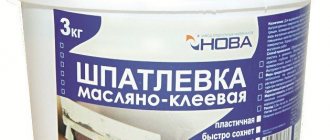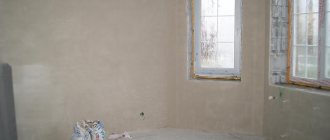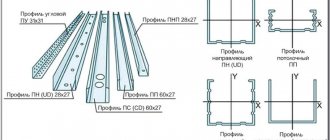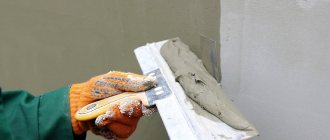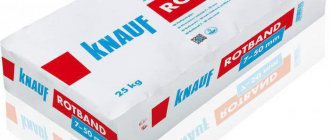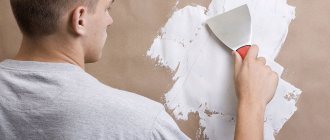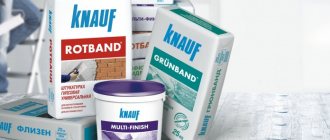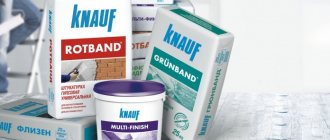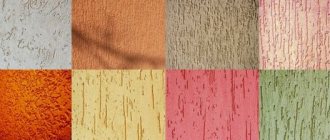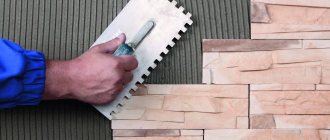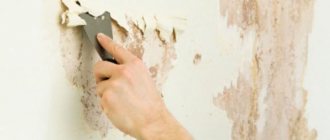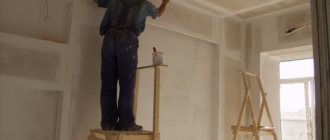Home / Installation, repair, maintenance / Sealing holes and cracks / Instructions for using Fugenfüller putty
Many of those who made repairs on their own and were involved in leveling ceiling surfaces are familiar with the word “fugenfüller”. This is not surprising, since we are talking about one of the most popular putty mixtures.
Features of use
Knauf brand Fugenfüller (Fugen) putty is stable after drying and does not form cracks. Consists of natural eco-friendly materials that are harmless to human health.
Characteristics:
- The manufacturer's recommended layer thickness is 1-3 mm. If used to seal gypsum board joints, it is applied twice;
- The consumption when working with different surfaces is different: to process drywall joints and screw heads you will need 0.25 kg; consumption for tongue-and-groove tiles – 1.5 kg/m²; continuous gypsum board coating – 0.8 kg/1 m² with a layer thickness of 1 mm; leveling plastered walls (consumption depends on the level of roughness) – 1 kg/1 m².
Extra options:
- Fraction size – no more than 0.15 millimeters;
- Compressive strength – 3.0 MPa;
- The level of bending strength is 1.5 MPa;
- To obtain a finished solution weighing 1.3 liters, you will need 1 kg of the powdery contents of the package.
The mixture is available in three varieties:
- regular "Fugen";
- "Fugen GV";
- Fugen Hydro.
Main characteristics
There is no point in talking about all the variations of the compositions - they are very similar and are used in the same way. Only the type of surface on which they are used changes. Therefore, we will consider in detail only the main, simplest composition - an ordinary fugen.
It should be applied in a layer of up to 3 millimeters. If you make a thicker layer, the putty does not behave very well - sagging, grooves and other artifacts appear. So, for larger-scale leveling work, this mixture is not suitable.
The gypsum used as the base of the composition makes it dry very quickly. The lifetime of the finished solution does not exceed 30 minutes. Depending on the room temperature and humidity, this indicator may vary slightly. Therefore, you should not dilute tens of kilograms of the mixture at once - you won’t have time to use it all.
There are no large particles in the composition. The size of the main fraction is 0.15 millimeters and this makes it possible to obtain very even planes. After puttying, the surface is ready for painting or wallpapering, even without subsequent sanding.
The only thing to consider is that after drying the surface does not have an even coloration. The color may be uneven, and when painting, this matters. It is better to pre-treat the putty surface with colored primer or paint it in several layers.
Positive qualities and disadvantages of Knauf putty
Pros:
- The product is suitable for working with drywall;
- The resulting seam is durable, and its creation requires low material consumption;
- Gypsum is a clean material that does not pollute the environment;
- After drying, the putty firmly adheres to the surface being treated;
- It's easy to work with her.
Flaws:
- Dries quickly. True, this is not always a disadvantage of the product;
- Cannot be used for large bends - maximum 3 mm;
- Complex grinding process.
Putty "Fugen Hydro"
From the name it is clear that the Fugen Gidro material is moisture resistant due to hydrophobic additives in the mixture. Suitable for:
- filling joints between sheets of moisture-resistant plasterboard (GKLV, GKLVO);
- gluing moisture-resistant drywall to a leveled surface, gluing and puttying gypsum products;
- filling cracks and depressions in concrete floors;
- installation and puttying of moisture-resistant tongue-and-groove slabs.
The characteristics and consumption are the same as the universal Fugenfüller composition, with the exception of the maximum layer thickness, which is 5 mm.
Available only in 25 kg bags. The price for moisture-resistant putty is almost 2 times higher than for regular putty.
Area of use
The putty composition can be used for various purposes without the risk of loss of properties:
- filling suture joints of concrete floors;
- finishing of drywall (the solution is laid on the joint areas);
- restoration of gypsum plasterboard, concrete, tongue-and-groove slabs;
- plastering the entire surface of the structure (partitions, walls);
- reinforcement (putty is used to attach mesh and reinforcing corners);
- fixing plasterboard sheets on a pre-leveled vertical surface;
- create a rough base on top of sheets of drywall for wallpapering;
- filling the recesses at the fastener installation points (the caps are hidden).
Packaging and storage
The KNAUF-Fugen mixture is packaged in paper bags of 5, 10 and 25 kg. Packaging 5 kg can also be produced in plastic packaging. Bags of KNAUF-Fugen dry mixture should be stored in dry rooms on wooden pallets. Use material from damaged bags first. Shelf life in undamaged paper packaging is 6 months from the date of manufacture, in plastic packaging - 12 months. The date of manufacture is indicated on the side of the bag. Upon expiration of the shelf life, the packaging and product must be disposed of as household waste.
Recommendations for working with gypsum putty
Gypsum putty has one property that affects the entire work process - it dries quickly. Therefore, it is more economical to use dry mixtures, since undiluted powder can be stored for a long time.
Work moment
Gypsum mixture Knauf Fugen (Fugenfüller) is applied exclusively to flat surfaces. But to smooth out cracks and roughness, the layer should be maximum - 3 mm and applied twice.
The mixture is diluted in a small clean container. The thicker the structure of the putty, the less likely it is to form lumps. But this consistency is used for repeated application, and for the first layer a more liquid one is prepared; lumps do not play a special role here, they are leveled out when distributed over the surface.
For puttying, narrow spatulas are used: 15-20, 20-25, 30-50 cm. Which one to choose is guided by the unevenness of the surface being treated.
Types of putty mixtures
The main purpose of putty mixtures is finishing and leveling various surfaces, sealing cracks and potholes in the wall. The Knauf company offers a wide range of materials for different jobs. Let's consider all existing types of products of this brand.
By composition
There are three types of Knauf putties on the construction market today, which differ in the components included in their composition:
- gypsum;
- cement;
- polymer.
Knauf gypsum putties are distinguished by their affordable price, ease of leveling and complete absence of shrinkage. The main disadvantage of this product is its low resistance to moisture. Because of this, these compositions are applicable only for interior decoration of dry rooms. Cement putty compositions are highly resistant to moisture, but high shrinkage can also be noted here.
Instructions for use
To obtain high-quality coverage and avoid erroneous actions, you should strictly follow the instructions. In particular, start work when the surface is cleaned and dried. You should also not allow dirt or foreign bodies to get into the putty. Tools must also be clean.
There are several ways to use the Knauf-Fügen dry mixture:
- continuous surface coating;
- installation of KNAUF-gypsum board partitions;
- processing of joints of gypsum board sheets.
Each case has its own characteristics that should be taken into account. Otherwise the work will have to be redone.
Complete puttying of concrete surfaces
The solid technique is used in case of minor unevenness. Buying expensive putties is not practical from an economic point of view. A day before the start of work, the surface is primed.
The putty is applied to the walls using a spatula or trowel. Any technique is used that is convenient. For example, cross-shaped - first follow vertical stripes, then change direction to horizontal movements for leveling. Or perform fan-shaped manipulations.
The thicker the layer, the more liquid the plaster should be.
Installation of KNAUF gypsum boards
Putty is convenient when attaching plasterboard. During installation, the solution is applied to the recesses of the slabs:
- bottom row groove;
- vertical groove from the end part.
Next, the gypsum board is pressed tightly, and the remaining remaining mixture is removed. The process is reminiscent of laying bricks using cement mortar. When the installation of the slabs is completed, the seams are sealed with fugagypsum putty.
Sealing joints of plasterboard sheets
Processing of gypsum board seams is carried out in several approaches. The Uniflot composition was developed specifically for these zones. The sequence of actions varies depending on the type of edge. It can be straight or folded. Processing joints of gypsum board sheets with a straight edge:
- The seams are filled with putty to the full depth, maintaining uniformity.
- Wait until the mixture dries, then clean the surface of the closed joints.
- Cover the sheets with a leveling layer of putty mixture.
Adjacent gypsum board sheets relative to a straight edge are mounted with a gap of 5 to 7 mm. Sequence of actions in the case of a folded edge:
- To begin, apply the first layer of putty.
- A special reinforcing tape or fine mesh is applied and pressed into the putty mixture with a spatula to avoid the appearance of wrinkles and bubbles.
- A second leveling layer is applied to the dried surface.
- When the putty dries, the joints are sanded.
Note! It is convenient to carry out the work with a 150 mm wide spatula. Moreover, it is advisable to choose a tool that has a handle in the form of a screwdriver tip, in order to tighten protruding screws at the same time.
Plastering is a simple operation that requires only time and patience
Aligning corners
In general, this procedure does not apply to putty, but it is recommended to do this without plastering. If you want beautiful, right angles even if the walls are not level (not plumb) - forget about corner spatulas, a rule is needed here. The closer the height of the walls to the rule, the better. If the ceiling height is 2.5 meters, the rule is needed a little less so that it can be placed vertically in a corner and work with it freely. You can, of course, use a 1.5 meter one, but then you will have to spend more time and the result will be less impressive.
So, the corner consists of 2 adjacent walls; we will stretch each wall of one corner in turn. We apply a thick fugen to the wall along the entire height of the corner, so that there is at least a centimeter layer from the corner to the side of 30-40 cm. Next, we place the rule in the very corner and stretch it to the side along the applied putty. As a result, we get a vertical plane of putty mass, which must be eliminated as a rule after 30-40 cm from the corner. In order not to spread too much, while pulling the rule needs to be pressed into the wall, it will rest on the protruding sections of the wall and remove the excess, but in the places of the holes the mass will remain and become level with the protruding areas. Particular attention should be paid to the geometry of the resulting result; if various grooves have formed, there is no need to try to smooth them out with a spatula or trowel - after the mass has set, these defects will be eliminated with putty, the main thing is to make the angle in one line from floor to ceiling. Having trimmed half a corner in this way, move on to the next ones. It is recommended to go through the second wall of each corner using the same method after the first brushes have set. This is how we get unsightly corners due to the grooves, but their geometry is predetermined and it’s up to the putty.
In addition to the vertical corners, you can also trim the horizontal ones, where the ceiling or floor meet, so that the ceiling molding or plinth, when installed, does not show the curvature of the walls. However, then a reasonable question arises - if there is so much labor involved, wouldn’t it be more technologically advanced to plaster the walls along the lines so that all the corners are even and the walls themselves are also ideal? It's up to you to decide here, but I'll just say that pulling out the corners can be done with a fugen or a plaster gypsum mixture, for example a rotband from the same manufacturer. The advantage of rotband in this case is that it sets faster.
Technical and operational characteristics
Fugen putty from Knauf has the following qualities and application features:
- Like any finishing composition, the material has a fine-grained structure. The largest permissible fraction size is 0.15 mm.
- The maximum layer thickness is 3 mm, the minimum is 1 mm.
Puttying the seams between sheets of drywall is done in 2 layers.
- In order to get 1.3 liters of ready-made solution, you need to take 1 kg of dry mixture.
- Repair work with putty can be carried out in an apartment at a temperature not lower than +10 degrees.
- The time during which the prepared solution is suitable for use is 30 minutes.
- The shelf life of Knauf putty, like any other, is short and is 6 months.
Physical characteristics:
- compressive strength – 3 MPa;
- bending resistance – 1.5 MPa;
- adhesion to the surface – at least 0.5 MPa.
Putty consumption depends on the type of work and the substrate:
- Sealing drywall joints requires an average of 0.25 kg per 1 m2.
- Consumption for the same area for continuous puttying with a layer of up to 1 mm is 0.8–1 kg.
- The installation of tongue-and-groove slabs requires almost 2 times more putty, namely 1.5 kg.
The universal mixture “Fugen” is sold in paper bags, packaged in 5, 10 and 25 kg. It is recommended to store them on wooden pallets.
If the packaging is damaged, the mixture must be poured into an empty bag and used up as soon as possible.
The price for gypsum putty is almost the same in all regions of the country and is about 400 rubles. per bag weighing 25 kg.
What is Knauf Fugen putty?
Products of this brand are considered when planning to carry out interior work. Restrictions on use are due to the composition: this material contains gypsum. This component does not tolerate constant contact with moisture. In addition to gypsum, Fugenfüller putty contains auxiliary additives that improve the properties of the material. These include components that slow down the setting of the mixture and retain water.
The need to use such additives is due to the fact that the gypsum solution hardens quickly. To increase the duration of work with it when applied to the surface, components are added that prevent moisture evaporation. Due to this, the mixture retains its viscosity longer.
Thanks to the plasticity of the mass, it is easy to work with. You can model seams of the desired shape. However, this does not mean that Knauf gypsum putty remains viscous for a long time. Complete hardening is delayed by adding plasticizers for a short time. To find out exactly how long it takes “Fugenfüller” to dry, you need to study the instructions for the selected product.
The thickness of the mixture layer varies between 1-5 mm. You can more accurately determine the value of this parameter if you have already decided for what purpose the material is used. Gypsum putty “Knauf Fugen” 25 kg is in greater demand. On sale you can find packaging with a capacity of 5 and 10 kg. To prevent the material from losing its properties during storage, the bags should be placed on wooden pallets. This will prevent the putty from getting wet. It is produced in the form of a dry mixture.
It is recommended to create suitable conditions for working with putty. The optimal room temperature is +10°C. The warmer the room, the faster the material will harden. If Knauf starting putty is selected, its characteristics will not allow work to be done in conditions of low humidity. In this case, the composition quickly hardens, reducing the quality of the coating.
It is recommended to carry out repair and finishing work in humidity conditions of 70-80%. Due to the high rate of hardening, a small amount of material should be prepared. If you make a lot of putty at once, it will harden ahead of time, and it will be impossible to use it after that.
When you plan to carry out work using the Fugenfüller composition, the consumption must be calculated taking into account the type of mixture (various gypsum-based finishing materials are produced under the Knauf brand). In addition, the type of material from which the structure being processed is made (plasterboard, concrete, etc.) also plays a role.
It is also necessary to take into account the conditions in which the work is carried out: air parameters. For example, to perform rough finishing of gypsum boards, material is prepared at the rate of 0.8 kg per 1 m2. If you plan to apply the finishing layer, use the composition in an amount of 1 kg/1 m².
The amount of coatings also affects the material consumption. For example, if the composition will be used only to complete the base layer, it is enough to apply it once. When the putty mixture is used for roughing, finishing and fastening reinforcement between these layers, the consumption increases several times.
Different types of putty mixtures are produced under this brand:
- “Knauf Fugen GV”;
- Fugen Hydro;
- universal gypsum putty.
The first 2 options are highly specialized materials. For example, “Fugenfüller GV” is a composition developed for finishing supersheets made of Knauf brand plasterboard. The putty is available in the form of a dry mixture. The main component is gypsum; it additionally contains polymer additives to improve properties. Application of this type of putty mixture:
- full plasterboard covering;
- filling seam joints during installation of gypsum boards and Knauf floor elements (PE);
- restoration of damaged plasterboard sheets and floor elements: when scratches, chips appear, as well as at fastening points;
- performing various internal works, in addition to those listed above.
This type of putty mixture differs from analogues in its increased elasticity. This ensures tensile strength. According to this parameter, the material corresponds to the processed Knauf supersheets. Due to this, the service life of the coating increases, since the risk of cracking of the putty layer when operating conditions change is reduced. The shade of the mixture can be different: white, gray, pink, which is due to the presence of natural impurities in the composition.
“Knauf Fugen Hydro” is a putty mixture intended for walls (interior decoration). It is distinguished from other types of materials by its moisture resistance. This is due to the presence of hydrophobic additives in the composition. The main purpose of the material is finishing and filling the seams of moisture-resistant plasterboard sheets. The advantages of the putty mixture include resistance to cracking. The material does not shrink. The putty is environmentally friendly. It does not pose a danger to human life and health when used inside residential buildings.
Universal gypsum putty
This option is the most common due to its wide range of applications. Universal gypsum putty “Knauf Fugen” contains polymer additives. The material is susceptible to moisture. However, this will not affect its service life if you protect the coating from water after application or use the composition only in rooms with normal humidity levels.
The material is used for finishing structures made of different materials (concrete, plasterboard, gypsum fiber material, Knauf supersheets). However, the composition is not used outside the premises. Thanks to polymer additives, the likelihood of cracking of the coating is reduced.
Dilution of Knauf brand gypsum putty
Dilution rules and consumption are indicated on the manufacturer's packaging.
You will need a small clean container, a bucket will do. Pure cold water is poured into it (0.8 liters of liquid will require 1 kg of powder). Afterwards, pour out the required amount of putty evenly and little by little. The quantity should be such that the dry mixture exceeds the water level. Allow the putty to settle and soak in moisture for about 2-3 minutes. The mixture is mixed by hand, but you can use a mixer.
Correct structure
The use time for the solution is 30-40 minutes, so do not mix a large amount.
Advantages and disadvantages
Fugenfüller Knauf putty is valued primarily due to its advantages that are difficult to dispute. Among the obvious advantages it is worth highlighting:
- The building compound is used when working with gypsum plasterboard, even though the plasterboard surface is exposed to moisture, and also for puttying OSB and other materials.
- Due to their high strength, concrete surfaces are effectively joined.
- Environmentally friendly.
- Putty is produced in different colors.
- High adhesion, which is easily enhanced by additional primer treatment.
- Putty is applied in a different thickness range - from the thinnest to a more reliable coating. But within acceptable limits.
- The Knauf assortment contains a moisture-resistant option.
- Thanks to its fine-grained structure, the putty completely fills small cracks.
- Moderate consumption of putty contributes to economical spending on repair work.
Knauf offers three putty options to choose from, so it makes sense to consider the strengths of each individually.
Gypsum is a clean material that does not pollute the environment.
Even such a professional mixture has a number of disadvantages that must be taken into account first. This allows you to choose the only correct solution in each specific case.
One of the significant disadvantages is the high drying speed, which imposes certain inconveniences. In particular, you need to act extremely quickly and dilute small portions of the solution. With a large scale of work, this takes a lot of time. Other disadvantages:
- It is not recommended to use the material for large surface bends. When the level difference is 3 mm or more.
- Hardened gypsum coating is difficult to sand because it is very durable. At this stage, the worker requires endurance and considerable effort.
- If thin and light wallpaper is chosen for finishing, dark gaps may appear.
- The inconvenience lies in the maximum thickness of the applied layer - no more than 3 mm.
The main disadvantage is that it dries quickly in the mixing container.
Preparing the walls
The walls must be cleaned as much as possible of whitewash, paint, and crumbling parts. Often it is not possible to clean the walls of Soviet-era paint; in this case, what is removed is removed, and the wall, after being treated with a regular primer, is additionally treated with a concrete contact primer. Concrete contact has proven itself to be excellent, it exhibits good adhesion even to alkyd paints, the drawback is that it takes a long time to dry, subsequent work is recommended to be carried out no earlier than 12 hours after its application. These recommendations apply to concrete walls in panel houses; brick walls, as a rule, are not difficult to clean from paint and other things and you can get by with a regular primer. So, the walls are primed. Next, if plastering of the walls is not provided, you should tackle the corners.
Conditions and procedure for performing work
Before starting work using Knauf-Fügen putty, care must be taken to create suitable conditions. Any master needs to know this, especially beginners. The optimal temperature ranges from +10 °C to +30 °C.
Processing of plasterboard sheets should only begin after all “wet” processes have been completed, which lead to changes in temperature and humidity levels in the premises. This includes installation of self-leveling floors, plastering of walls and ceilings, installation and dismantling of windows (especially from autumn to winter).
You need to start putting putty when the surface to be treated is completely dry. Otherwise, linear deformation of the gypsum board and, as a consequence, cracking of the coating cannot be avoided.
It is also prohibited to add other components to the solution, otherwise the quality of the putty will decrease, and significantly! The manufacturer produces putties with a specially selected composition. It is undesirable to use a thickened mixture, as well as dilute it with water - this will not return the original properties.
Preparing the surface for puttying
Preliminary surface preparation is strictly necessary and neglecting this stage is highly discouraged. The first thing you need to do is get rid of the old finish - wallpaper, plaster. The base is thoroughly cleaned of other contaminants - mold (if any), grease deposits, dirt, dust. After cleaning, it is necessary to treat with a primer depending on the type of walls.
Processing the rough coating is a mandatory stage of the work.
Plasterboard structures
The frame is assembled according to technology, which avoids sagging of plasterboard sheets when creating ceilings or deformations of cladding and partitions. The sheets must be firmly fixed to the frame, in which the pitch of the fasteners plays an important role:
- 170 mm – ceilings;
- 250 mm – partitions.
The sheets themselves must be laid out in a staggered manner. The displacement of seams also has its own weight:
- 400 mm relative to vertical;
- 150 mm relative to horizontal.
The screw caps are covered with putty (Knauf-fugen). The end parts of the sheets should be cut at an angle of 22.5°, which is effectively achieved with a special tool (edge plane). Also, the ends must be primed with a deep penetration compound.
At the end of the preparatory stage, a primer is applied to the surface. You can use a brush, roller, spray. Wait until it dries - each type of primer has its own duration:
- Tiefengrund – 3 hours;
- Betocontact – 12 hours.
It is important to ensure that the treated surface does not become dusty again.
Seams and small recesses between sheets are coated with the composition using a spatula
Dilution of putty
Most beginners make a number of mistakes while still at the stage of preparing the mixture for surface treatment. Do not allow air to get in when mixing the mixture. For this reason, it is not advisable to use mixers or other mechanical devices. It is better to dilute portions manually. At the very least, the mixer speed should not exceed 300 - then air will not penetrate into the mixture during the mixing stage.
The kneading procedure has a number of features:
- On average, 0.8 liters of water are taken per kilogram of dry mixture. The exact proportions are indicated on the label for each Knauf product.
- The dry composition is carefully and gradually poured into a container of water for proper impregnation.
- When the mixture is poured, wait 2-3 minutes. This time is enough for the mixture to become saturated with water. Only then start stirring. If you start right away, you will not be able to achieve a uniform structure, and the putty will lose its technical characteristics.
- The temperature of the water for mixing the dry mixture plays an important role. Indicators should be kept within +5 °C to +30 °C. Due to warmer water, the moisture resistance of the mixture deteriorates and subsequently the coating will begin to crack after drying.
- It is advisable to mix the mixture manually with a spatula. Using a mixer at low speeds is important when you need to prepare a lot of solution - it is very difficult to knead such a volume with your hands (even with a shovel).
- The ready-to-use mixture should have a uniform, creamy consistency. Initially, the solution seems liquid during mixing, but you cannot deviate from the proportions and add more dry mixture. After some time, the consistency will come to the desired form.
Attention! You should not throw the remaining putty back into the container with the prepared mixture. This shortens the lifespan of the composition, which quickly renders it unusable.
The rate of consumption is affected by the type of finishing work
Differences in fugen operation
Fugen, like other gypsum putties, differs significantly from polymer, oil-adhesive and other putties. These differences lie not only in the properties of the finished surfaces, but also some aspects of the work are fundamentally different. The most important thing, in my opinion, is that the hardening of gypsum mixtures does not directly depend on the presence of moisture in them; in this way they are similar to cement-based solutions. This means that after the passage of time, which the manufacturer indicates as the “lifetime of the solution” (for fugen it is 30-50 minutes), the solution begins to harden (set) even if water is poured into a bucket of putty. You can, of course, mix water and putty, extending the “life of the putty,” but the properties and strength of the putty deteriorate. From all of the above, you should understand that you need to apply putties exactly as much as you use during the specified “lifetime”.
This seemingly disadvantage turns out to be a significant advantage when a wall that has just been puttied can be puttyed a second time; you just need to wait until the first layer has set, although complete drying may take a longer time. I would like to note that the indicated working time of the putty should not be taken literally and begin to apply the second layer immediately after an hour has passed. Here you need to orient yourself on the spot; to apply the next layer, the first layer must be sufficiently strong so that subsequent actions do not damage it. The hardening time is significantly influenced by the thickness of the layer and the absorption of moisture by the surface. Usually the first layer takes the longest to set, but subsequent ones can usually be puttied immediately after applying the previous one.
When working with gypsum mixtures, it is important to wash the working tools immediately after making the next batch. If this is not done, the tool will quickly “overgrow” and become unusable. By the way, dirty tools and the container in which the gypsum mixture is applied shortens the life of the solution.
Consumption
How much putty is required depends on the type of work. The type of surface being treated also plays a role in this. When sealing plasterboard joints, the consumption per 1 m2 of surface will be 250 grams. In the case of continuous application of putty - from 800 g to 1 kg per square area with a layer thickness of no more than 1 mm.
If you need to cover an already plastered surface, then the putty consumption will be slightly higher (0.8-1.2 kg per square area), depending on the degree of roughness of the rough coating. As for the installation of tongue-and-groove slabs, you should take into account the figure of 1.5 kg per 1 m2.
Commercially available varieties
Depending on the location where the material is applied, you should choose the appropriate type of putty. The manufacturer offers putty for gypsum fiber sheets - Knauf Fugen G.V. and material for work in places with high humidity - Fugen Hydro.
The first option is intended for sealing seams and minor irregularities. In terms of its composition, this mixture has almost the same composition as the universal remedy. The differences lie in the permissible thickness of the applied layer and the consumption of the prepared substance.
To cover seams and joints, up to 600 grams of mixture is required. With a continuous application of raw materials 1 millimeter thick, up to 1.2 kilograms will be required. Otherwise, the material has similar characteristics to the universal mixture.
The second material contains special additives that allow it to be used:
- For the purpose of gluing moisture-resistant drywall to a flat surface, as well as puttying and gluing gypsum raw materials.
- For filling joints between sheets of plasterboard in damp rooms.
- As an element for filling cracks or depressions in concrete floors.
- For filling and installation of tongue-and-groove moisture-resistant slabs.
The remaining characteristics are no different from the universal composition of Fugenfüller putty. The maximum thickness of the applied layer should not exceed 5 mm. A moisture-resistant analogue will cost twice as much as universal products.
Puttying with fugen
The whole process differs from the usual in that the applied putty is removed with a spatula located perpendicular to the surface to be putty. Layers should be alternated in directions: if the previous layer was applied from bottom to top, then the next layer should be applied as desired, but try to remove the mass from left to right or from right to left. This method is also called “tear up” putty. Some authors argue that this method is only appropriate when the walls are initially very smooth, but I will answer this way: very curved walls can also be puttied this way, just 2 layers are not enough. In this way you will have to putty at least 4 times.
Most of the material goes into the first layer; in fact, the purpose of the following layers is to tidy up the first one. You can also putty with fugen in the usual way - by smoothing the mass at a slight angle, the essence is simple - the closer the surface of the entire spatula is to the wall, the smoother the result will be. But the more attractive the wall looks after one coat, the more ripples and unevenness you will add to the wall. You should putty with fugen so that when removing the applied mass, the spatula is approximately 90 degrees to the wall. The first layer will give the impression of being “not very good”, but after the second and subsequent layers you will understand that you are on the right track. An excellent result on curved walls can be achieved by plastering the first 1-2 layers with a short meter rule, using it as a spatula.
When one or more layers have already been applied to the wall, an unpleasant phenomenon occurs: when removing the applied mass, particles from the previous layer get into the putty, the old particles leave grooves, because of this, the putty begins to harden faster on the putty and you have to throw out small portions from the putty when puttingty it gets hard. To minimize this phenomenon, before application you should cut off the “snot” remaining from the previous layer with a spatula. And you should try to putty immediately after the previous layer has hardened - the surface is still wet and absorbs moisture less actively, this will significantly increase the life of the putty on the spatula.
Surface preparation and application
Preliminary preparation of surfaces is mandatory, since otherwise cracks and unevenness will appear on the dried putty. To begin with, they get rid of the old finishing - wallpaper, plaster. The base is cleaned of dirt, mold and grease. Afterwards, a layer of special primer is applied using a roller; its choice depends on the type of base.
To work with finished putty, monitor the room temperature; it should exceed +10 degrees. Avoid drafts and exposure to moisture.
Puttying gypsum board joints is carried out in several stages: the first layer is applied, then reinforcing tape or a small special mesh is applied and pressed in with a spatula to avoid the formation of folds or bubbles. The final stage - applying the second layer, is done on the already dry surface with gentle movements.
If you need to cover the entire surface area of the walls, use a wide spatula (150 mm).
Sanding walls
It is recommended to sand the walls after applying the last layer, and in the intermediate stages it is best to cut off various bumps and defects with a spatula. If you sand between layers, the sanding dust will cause the putty to quickly set on the putty knife and cause grooves to appear on the surface. To eliminate this unpleasant phenomenon, you will have to prime the walls again every time after sanding. And on a primed wall, the newly laid layer will take longer to set. In general, this procedure is not prohibited, it simply increases the total time of work.
Types of Knauf Fugen putties
Various types of putty are available for sale:
- "Fugenfuller" (Knauf Fugen) - standard Knauf mixture.
- Fugen GF is a composition intended for finishing works on plasterboard sheets (GKL).
- Fugen Hydro is a moisture-resistant gypsum composition for processing gypsum fiber materials.
Note! It is advisable to use each type of putty for its main purpose, based on the type of surface.
Fugenfüller or Knauf Fugen
The standard mixture for professional processing of joints of plasterboard panels does not crack after drying. For the manufacture of the composition, only environmentally friendly raw materials (gypsum) are used, and therefore there are no harmful emissions.
Knauf Fugen GF
Fugen GF mixture completely covers the entire surface of gypsum fiber sheets. The composition itself is durable and at the same time elastic. No cracks form on the treated and dried surface. The Fugen GF option is the same standard gypsum putty, but with the inclusion of polymer additives. There is no harmful effect on the human body.
Knauf Fugen GF – for continuous puttying of GVL
Knauf Fugen Hydro
This is a moisture-resistant gypsum option that is suitable for effective processing of gypsum board joints. It is also used when installing plasterboard slabs with tongue-and-groove fastening. When dry, the putty shrinks minimally and does not crack. Due to the content of environmentally friendly polymer and hydrophobic components, the mixture is resistant to moisture.
Knauf Fugen Hydro - moisture-resistant gypsum putty for treating joints
Comparison of Knauf Fugen and Fugen Hydro putties
The main difference between Fugen and Hydro putties is that Knauf-Fugen is a regular compound, while Fugen-Gidro is a moisture-resistant mixture. Due to the inclusion of hydrophobic components in the composition, Fugen Hydro putty is used to treat surfaces of rooms with high humidity.
Otherwise, there is no difference between these types of putties. Even the areas of application are largely similar.
Knauf fugen consumption per 1 m2
The ideal condition of the walls is the result that Fugenfüller putty can achieve, the technical characteristics of which are simply excellent. Why is she so good? Here are its main advantages:
- Minimum putty consumption per 1m2 (more details).
- No shrinkage.
- Does not crack.
- Ideal for drywall and other finishing materials.
Application
Can be used for repair and finishing work inside residential premises. Among other things, Fugenfüller Knauf putty is perfect for creating complex architectural forms (protrusions, stucco molding, arches) both with and without the use of reinforcing tape. Experts like that it can act as an adhesive for any gypsum structures.
Of course, the Knauf Fugenfüller putty is created clean from an environmental point of view; it can even be used when renovating children's rooms for very small children and rooms where people with allergies will live.
Consumption of materials
Material Type of work Quantity
| KNAUF-Fugen | Sealing joints of KNAUF sheets Sealing joints of KNAUF supersheets Continuous puttying with a layer thickness of 1 mm Installation of KNAUF gypsum boards (tongue-and-groove slabs) | 0,25 0,3 -0,6 0,8-1 1,5 |
| KNAUF-Tiefengrund | Priming of absorbent surfaces of gypsum plasterboard, gypsum fiber board, plastered surfaces | 0,1 |
| KNAUF-Betokontakt | Priming of dense and concrete surfaces | 0,23 |
Continuous puttying with Fugen
Many finishers and “not so many” are familiar with such a wonderful dry putty “Fugen” (formerly it was called Fugenfühler). It is usually used for sealing drywall joints, puttying holes and corners. For continuous puttying of walls, it is used much less often - it does not have the proper “ductility”, it is difficult to sand, does not have a white color and in general, it is harder for it to work. However, after understanding it a little, it becomes clear that the putty is very versatile, it can replace several types of other putties in repairs, it is much stronger than “its polymer counterparts,” and the consumption of this material is very pleasing. To putty a standard room in a panel, a 25-kilogram bag is enough.
Knauf Fugenfüller Gv
The composition of the powder mixture is gypsum and polymer additives. Fugen Gv is used for sealing seams, gluing gypsum fiber boards, and leveling other defects in gypsum fiber sheets.
Packaging Fugenfüller Gv
- The surface must be cleaned, and the gypsum fiber sheets themselves must be firmly fixed.
- Fugen Gv Knauf putty can be diluted, like others based on building gypsum.
- The contents of the powder are poured into cold water, allowed to brew for 2-3 minutes, and only then kneaded by hand. Operating time – 40 minutes.
- There should be no sudden temperature changes during repair work. The seams are filled with GV putty, the excess is wiped off.
- After complete drying, apply a second layer. At the end of processing, roughness and unevenness are eliminated using sandpaper and mesh.
Putty for GVL: “Knauf Fugen GV”
In the line of putties, there are several mixtures that have some differences in technical characteristics due to the characteristics of the composition. One of the options is “Fugen GV”. This putty is suitable for sealing seams and small irregularities in gypsum fiber (GF) sheets.
The properties of “Fugen GV” are almost no different from the universal mixture. Of course, there is some difference, for example, a slightly larger thickness of the applied layer is allowed - up to 5 mm. The mixture consumption of Fugen GW is also higher:
- to seal seams and joints, an average of 0.3 to 0.6 kg of mixture will be required;
- for a continuous layer 1 mm thick – from 1.2 kg.
This is where the differences end. The strength, fraction size and packaging are similar.
Advantages of walls plastered with fugen
The surface is very durable, breathable and absorbs moisture, and in general acquires the natural properties of gypsum. The surface is almost not softened by water, unlike some popular polymer putties; it cannot be simply washed off the wall with a damp rag. At the same time, if during work the doors, tiles, etc. are a little smeared, the fugen can be easily washed off from them, provided that the “smear” is within reason. Walls plastered with fugen will be ready for wallpaper again in a few years, provided that the previous wallpaper is removed with due care. With some skill, you can use this putty to putty the walls and ceiling before painting; to do this, the last layer must be applied with a liquid, kefir-like mass. Don't be confused by the grayness of this material; it paints over beautifully. But you should take on finishing putty for painting after you have gained enough experience. If you are new to this business, it is recommended to coat the surface to be painted with a finishing gypsum mixture.
Advantages and disadvantages of products
Putty of this brand has its advantages:
- High strength. When changing wallpaper during the next renovation, you don’t have to worry about the integrity of the coating.
- Minimum consumption. With high-quality leveling of the walls, the consumption of raw materials will be insignificant.
- High quality surface after finishing, suitable for painting or wallpapering.
- Reasonable price for people with average income.
Among the most significant shortcomings of the product are:
- Fast drying. If you have some experience, this disadvantage can be considered an advantage.
- Difficulty in carrying out grinding work. This process will require some effort on the part of the worker.
- The maximum thickness of the applied layer, which cannot exceed 3 mm.
- The possibility of dark gaps appearing when gluing light and thin wallpaper.
